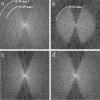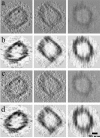Radiation dose reduction and image enhancement in biological imaging through equally-sloped tomography
- PMID: 18771735
- PMCID: PMC3099251
- DOI: 10.1016/j.jsb.2008.07.011
Radiation dose reduction and image enhancement in biological imaging through equally-sloped tomography
Abstract
Electron tomography is currently the highest resolution imaging modality available to study the 3D structures of pleomorphic macromolecular assemblies, viruses, organelles and cells. Unfortunately, the resolution is currently limited to 3-5nm by several factors including the dose tolerance of biological specimens and the inaccessibility of certain tilt angles. Here we report the first experimental demonstration of equally-sloped tomography (EST) to alleviate these problems. As a proof of principle, we applied EST to reconstructing frozen-hydrated keyhole limpet hemocyanin molecules from a tilt-series taken with constant slope increments. In comparison with weighted back-projection (WBP), the algebraic reconstruction technique (ART) and the simultaneous algebraic reconstruction technique (SART), EST reconstructions exhibited higher contrast, less peripheral noise, more easily detectable molecular boundaries and reduced missing wedge effects. More importantly, EST reconstructions including only two-thirds the original images appeared to have the same resolution as full WBP reconstructions, suggesting that EST can either reduce the dose required to reach a given resolution or allow higher resolutions to be achieved with a given dose. EST was also applied to reconstructing a frozen-hydrated bacterial cell from a tilt-series taken with constant angular increments. The results confirmed similar benefits when standard tilts are utilized.
Figures









References
-
- Averbuch A, Coifman R, Donoho D, Israeli M, Shkolnisky Y. A Framework for Discrete Integral Transformations I – the Pseudopolar Fourier Transform. SIAM J. Sci. Comput. 2008;30:764–784.
-
- Brenner DJ, Hall EJ. Computed Tomography — An Increasing Source of Radiation Exposure. N. Eng. J. Med. 2007;357:2277–2284. - PubMed
-
- Briggs WL, Henson VE. The DFT: An Owners' Manual for the Discrete Fourier Transform. SIAM; Philadelphia: 1995.
-
- Castano Diez D, Mueller H, Frangakis AS. Implementation and performance evaluation of reconstruction algorithms on graphics processors. J. Struct. Biol. 2007;157:288–295. - PubMed
-
- De Rosier DJ, Klug A. Reconstruction of Three Dimensional Structures from Electron Micrographs. Nature. 1968;217:130–134. - PubMed
Publication types
MeSH terms
Substances
Grants and funding
LinkOut - more resources
Full Text Sources
Other Literature Sources
Medical
Research Materials

